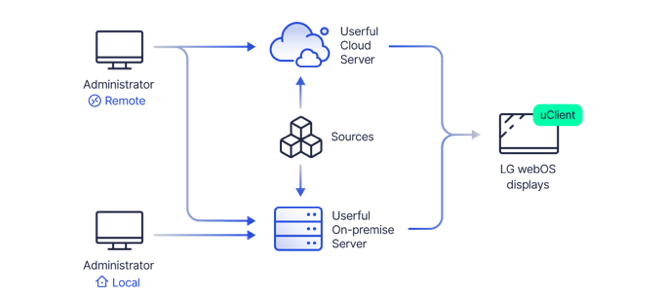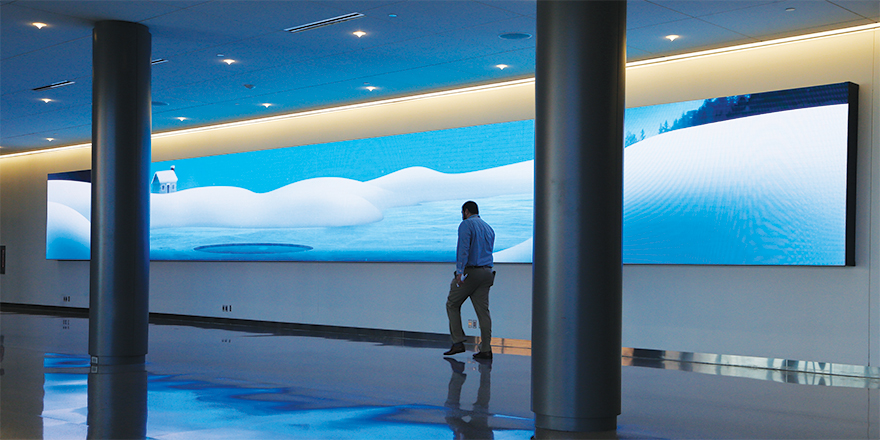The Growing Visual Communications Market
Most displays in the enterprise have traditionally been associated with desktops and workstations. However with growing demand to visually communicate and collaborate, use of large format displays and LED walls has increased across the enterprise. As companies scale their visual communication strategies the need for a cost-effective solution to manage all displays becomes critical. Total cost of ownership (TCO) is the best way to judge long-term costs as it includes both deployment and operating costs.
Most companies now run their core business applications in the cloud on a software as a service (SaaS) model that is optimized to take full advantage of on-demand CPU, bandwidth and storage tailored to the needs of the business. This has resulted in an optimized predictable cost model which delivers a lower TCO to IT departments.
Until recently, AV has been an outlier to this model with deployments often driven by proprietary AV hardware for single purpose video walls, digital signage, operational signage, mission-critical or executive dashboards or NOC/SOC video walls. Deployments of this kind live in an isolated pool, often lacking basic network features allowing for integration to the enterprise IT infrastructure. This approach has never been optimized for management by IT departments but rather by costly certified engineers of a particular solution. The IT department becomes wholly dependent on the vendor for any changes required as business requirements change. Simply put, AV hasn’t kept pace with the needs and operations of IT, resulting in costly legacy siloed AV pools across the enterprise, and a high TCO not sustainable as digital transformation initiatives continue to increase.
LG and Userful Lead the Evolution
LG and Userful offer a combined platform solution to solve this problem. Together we have introduced the first in industry managed solution leveraging Userful’s Visual Network Platform software and LG’s award-winning SOC displays embedded with LG webOS.
The result is a platform for AV applications that enables IT departments to run and manage all their displays and applications over the network. Unified communication has been widely adopted, built on the benefits and rapid technological advancements on switching and routing infrastructures. Support for Quality of Service, in the form of traffic classification, queueing or scheduling and bandwidth provisioning are now well understood, easy and cost-effective to implement. Visual content is just another source of traffic that is transported across the network with the appropriate quality of service. As a result of Userful and LG’s combined solution, enterprise IT departments can now deploy and manage AV deployments in a standards-based network service in line with best practices of IT.
The combined LG webOS and Userful solution reduces TCO in eight key ways:
1) Userful with LG webOS displays requires less hardware than visual display solutions of similar class (in fact sometimes no hardware at all), lowering initial CAPEX.
2) When hardware is required with Userful, it’s always commercially available and off the shelf. There are no black boxes, no specialized or proprietary AV devices.
3) Less hardware reduces the need for installation of additional power outlets, simplifying the installation process and reducing the need for system-wide electrical upgrades.
4) Less hardware also means less electricity used.
5) Most customers can simply use their existing network, saving the hefty costs related to network upgrades.
6) With flexible setup and training options, Userful also reduces deployment costs – getting you up and running quickly.
7) Userful reduces long-term costs for an enterprise by reducing the number of vendors needed to manage the various AV silos across the enterprise. Userful is a platform and can be used for any visual display application across the enterprise.
8) The Userful platform serves multiple use cases. For example, adding an executive dashboard to an existing NOC/SOC deployment or digital signage can be accomplished with the same Userful software. Scale limitlessly by adding servers and licenses, not new vendors with more products to learn.
As the number of visual display applications across the enterprise mushrooms, this final point is one of the most important. Organizations can no longer afford to evaluate, deploy, learn and train their teams on multiple point solutions for every display application required. A single platform which can be used for everything from a video wall in a control room to digital signs for customer or employee engagement, offers a compelling long-term reduction in total cost of ownership.
To make it easy for LG customers to get started with Userful’s Visual Networking Platform, Userful is offering free 1 year subscriptions to Userful Standard with purchases of select LG webOS displays, until December 31, 2020.
To learn more about Userful and this special offer, visit userful.com/lg






